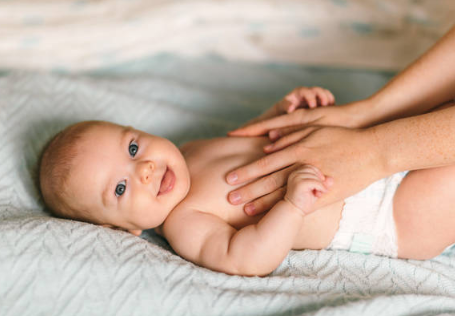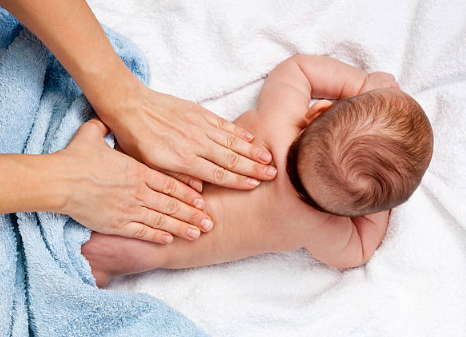Babies and their parents have enjoyed baby massages for centuries. This activity fosters parent-child bonding, but the benefits are not just nurturing. Studies have shown that infant massage can improve the quality of sleep for babies and their parents, reduce stress, promote brain and physical development, improve non-verbal communication, and more.
In short, incorporating baby massage into your daily care can be hugely rewarding, so it’s worth taking the time to do it. Here are some baby massage tips every parent should know – remember to check with your healthcare provider if you have any questions.
Benefits of Baby Massage:
Interaction. Baby massage helps parents spend quality time with their babies and promotes feelings of attachment, love, and trust. This early intimacy with parents can encourage children to develop empathy and self-confidence.
Stimulate. Infant massage stimulates all body systems, including the digestive, immune, hormonal, and circulatory systems, as well as muscles and joints. The baby’s body awareness may improve, leading to improved coordination and balance.
Ease. Massage may help relieve gastrointestinal issues such as colic, as well as constipation, teething discomfort and growing pains.
Just relax. Infant massage can improve the sleeping habits of babies and their parents, while reducing stress hormones and increasing “feel-good” hormones.
Studies have also shown that infant massage can help with healthy weight gain, jaundice reduction, and pain relief. In addition, the baby’s cognitive abilities, pre-language skills, and motor development may also be improved by infant massage due to the interaction between the baby and the caregiver.
Introduction to Baby Massage
Ready to incorporate massage into your baby’s daily care? It’s never too early to start a massage as early as the doctor agrees (though, you should be extra careful if massaging a newborn).
Start by preparing supplies: a blanket or towel, and massage oil in a non-breakable container. Consult your doctor before using any massage oil and choose an oil that does not contain irritating ingredients or fragrances, such as food-grade oils. Test the oil in a small area of your baby’s skin and wait a day to make sure no irritation is occurring.
You should massage your baby when he is quiet but awake, not after feeding or when he is sleepy. Sit on the floor with your feet together and your legs in a diamond shape. Place a blanket over your feet and between your knees.
Take off your baby’s clothes, leave only the diaper, place your baby on the blanket and place your baby’s head on your feet. Gently stroke your baby from head to toe and say “hello”. If your baby is stiff, crying, or becomes fusy, move to a different part of the body, or simply end the day’s massage. If your baby responds well, start gently massaging your baby’s body from area to part.
Massage Your Baby’s Tummy
Rubbing your baby’s tummy can help relieve gastrointestinal problems such as constipation and gas, improve colic symptoms, and promote digestion. This is the best technique for parents (but note that if the umbilical cord has not fully healed, the abdomen should be massaged. )
- Hold your hand and let the edge of your little finger move like a paddle across your baby’s belly. Starting at the base of your ribs, stroke down with one hand, then with the other, in a paddle-wheel motion.
- Use your fingertips to gently massage your abdomen in a clockwise circular motion.
- Do the “I love you” touch: Draw the letter “I” on the left side of your baby. Then draw an inverted “L” and stroke the abdomen along the base of the rib cage from right to left and down. Draw an inverted “U”, starting below your baby’s right side, up and around the navel, then down to the left.
- Turn your fingers clockwise around your navel.
- Bring your baby’s knees and feet together and gently press their knees up towards their abdomen. Rotate your baby’s hips to the right a few times. (This usually helps to expel the gas.) )
- Place your hands horizontally on your abdomen and shake them from side to side a few times.
Massage Your Baby’s Head and Face
A gentle head and face massage relieves stress, improves blood circulation, and promotes sleep before bed. There’s also good news for babies with poor hair follicles: a head massage can even promote hair growth!
- Support your baby’s head with both hands and massage the scalp with your fingertips, just like washing your hair. (Avoid the fontanelle, which is the soft part of your baby’s head.) )
- Massage the ears with your thumb and forefinger.
- Put your hands together at your chin and draw a heart shape on your baby’s face.
- Place your thumb between your baby’s eyebrows and stroke outward.
- Gently stroke your baby’s closed eyelid with your thumb again.
- Gently stroke from the bridge of the nose outwards to the cheeks.
- Massage the jaw in small circular motions with your fingertips.
Massage Your Baby’s Chest
When your baby has a cough, cold or respiratory infection, massaging the chest with therapeutic oil may help relieve symptoms. Even for healthy babies, a chest massage can improve breathing patterns and lung health. If your baby is sick, consult your pediatrician before massaging your chest.
- Place your hands on your baby’s chest and stroke from your sternum outwards to your shoulders.
- Starting with the sternum, draw a heart shape and raise your hands to your shoulders, then down and back together.
- In a criss-cross fashion, stroke diagonally from one side of your baby’s buttocks, up past the other shoulder, and back up to the buttocks.
Massage Your Baby’s Arm
As with the rest of the body, massaging a baby’s arms can help improve muscle tone and coordination, as well as increase body awareness.
- Hold your baby’s wrist with one hand. Gently pat the upper arm to relax the upper arm.
- Hold your baby’s wrist with one hand and wrap the other hand around the upper arm in a C shape; Stroke from the shoulders down to the wrists.
- Grasp each arm with both hands, one hand directly above the other, stroke from the shoulder down to the wrist, and rotate the hands in opposite directions, as if gently wringing out a towel.
- Massage the palms of your hands and use your thumb to move from the base of your palms to your fingers.
- Stroke the back of your hand from your wrist to your fingertips. Gently squeeze and pull each finger.
- Massage the wrist in small circles with your fingers.
- Turn their arms with both hands.
Massage Your Baby’s Back
Massaging your baby’s back regularly can help them get more comfortable on their stomach. If the pose makes them uncomfortable, skip this step and try massaging other areas that make them feel more comfortable.
- Lay your baby flat in front of you or place him on your straight leg. Place his hands in front of him, not at his side.
- Place your hands on your baby’s back and move each hand back and forth from the base of the neck to the hips (keeping them moving in the opposite direction).
- Hold your baby’s buttocks with one hand and stroke the other hand from the neck down to the buttocks.
- Use your fingertips to massage one side of your baby’s spine in small circular motions, then upwards to the other. Avoid compressing the spine directly.
- Massage their shoulders with small circular motions.
- Massage their buttocks with large circular motions.
- Use your fingers to stroke their back like a rake.
Massage Your Baby’s Legs
Although your baby may not be able to walk yet, a gentle leg massage can help release stress and promote relaxation.
- Grab the ankle of one of your baby’s legs and lift them up, then gently pat the upper thigh to relax.
- Hold the ankle with one hand and the other in a C-shape, thumb side down, around the upper thigh of your baby. Stroke from the thighs down to the feet.
- Grasp the thighs with both hands, one hand directly above the other, and stroke from the hips down to the feet, and rotate the hands in opposite directions, like twisting a towel.
- On the soles of the feet, massage from the heel to the toes with thumb-to-thumb movements.
- Use your entire hand to caress the soles of your feet from heel to toe.
- Stroke the instep. Gently squeeze and pull on each toe.
- Massage around the ankles with small circular motions.
- Roll your legs with both hands, just like kneading dough.
General Techniques for Infant Massage
Incorporating baby massage into your parenting routine is not difficult, but there are some general guidelines you should follow to maximize your efforts and ensure that your baby is safe and happy. Here are some tips to keep in mind when starting a baby massage:
- Do not massage your baby immediately after feeding. Wait at least 45 minutes, or wait until your baby is calm and awake before massaging – preferably before going to bed or after a diaper change.
- Strokes should be gentle but firm, not too itchy.
- Incorporate massage into your baby’s daily routine.
- Listen to your baby’s signals and decide when to stop the massage. A massage can last 10 minutes or 30 minutes, depending on your baby’s mood. Crying, writhing, or falling asleep are all signs that your baby isn’t feeling massaged.
- Consult your doctor before using any massage oil and avoid using oils that contain irritating ingredients. It is advisable to choose an oil that does not contain fragrances. Do not use massage oil around the eyes, ears and mouth. And don’t add any essential oils.
- Remember to relax and don’t worry too much about your skills. Talk softly to your baby, sing or hum a tune, and smile and tell them it’s a fun, loving activity that you can share with them.



